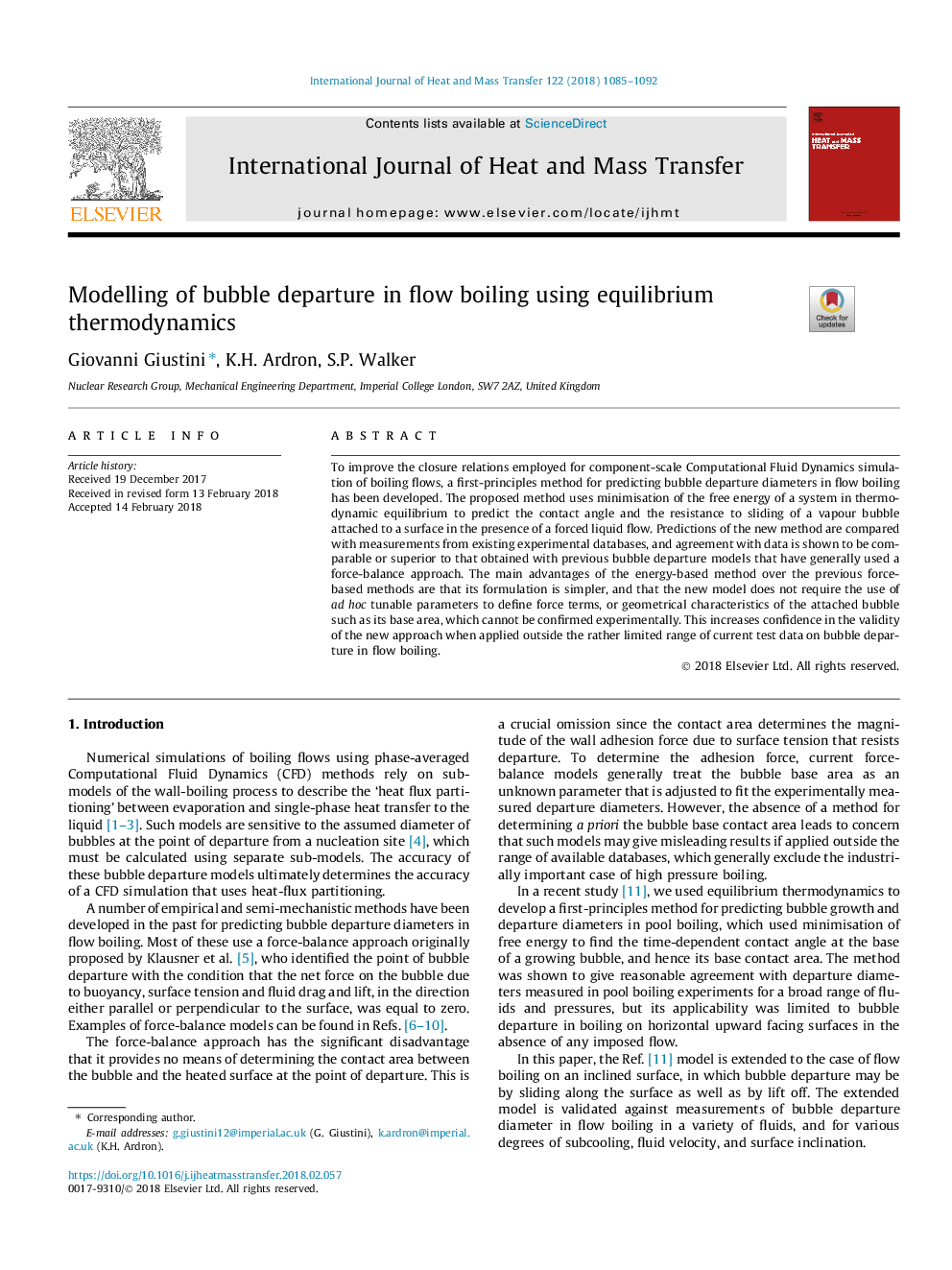| کد مقاله | کد نشریه | سال انتشار | مقاله انگلیسی | نسخه تمام متن |
|---|---|---|---|---|
| 7054466 | 1458018 | 2018 | 8 صفحه PDF | دانلود رایگان |
عنوان انگلیسی مقاله ISI
Modelling of bubble departure in flow boiling using equilibrium thermodynamics
ترجمه فارسی عنوان
مدل سازی خروج حباب در جریان جوش با استفاده از ترمودینامیک تعادل
دانلود مقاله + سفارش ترجمه
دانلود مقاله ISI انگلیسی
رایگان برای ایرانیان
ترجمه چکیده
برای بهبود روابط بسته شدن برای مقیاس کامپوزیتی دینامیک سیالات محاسباتی جریانهای جوش، یک روش اولیه برای پیش بینی قطر خروج حباب در جریان جوش توسعه داده شده است. روش پیشنهادی از کمینه کردن انرژی آزاد یک سیستم در تعادل ترمودینامیکی برای پیش بینی زاویه تماس و مقاومت در برابر کشویی یک حباب بخار متصل به یک سطح در حضور جریان مایع مجبور استفاده می کند. پیش بینی های روش جدید با اندازه گیری ها از پایگاه داده های آزمایشی موجود مقایسه می شود و توافق با داده ها نشان می دهد که قابل مقایسه یا برتر از آنچه که با مدل های پیش رونده حباب به دست آمده است، عموما با استفاده از رویکرد تعادل نیروی مورد استفاده قرار می گیرد. مزایای اصلی روش مبتنی بر انرژی بر روی روش های مبتنی بر نیروی قبلی این است که فرمول بندی آن ساده تر است و مدل جدید نیازی به استفاده از پارامترهای قابل تنظیم به طور خاص برای تعریف شرایط نیرو، و یا ویژگی های هندسی حباب متصل نیست مانند ناحیه پایه آن، که نمی تواند به طور تجربی تایید شود. این افزایش اعتماد به اعتبار رویکرد جدید هنگامی که در خارج از محدوده محدود از داده های آزمون فعلی در هنگام خروج حباب در جریان جوش استفاده می شود، افزایش می یابد.
موضوعات مرتبط
مهندسی و علوم پایه
مهندسی شیمی
جریان سیال و فرایندهای انتقال
چکیده انگلیسی
To improve the closure relations employed for component-scale Computational Fluid Dynamics simulation of boiling flows, a first-principles method for predicting bubble departure diameters in flow boiling has been developed. The proposed method uses minimisation of the free energy of a system in thermodynamic equilibrium to predict the contact angle and the resistance to sliding of a vapour bubble attached to a surface in the presence of a forced liquid flow. Predictions of the new method are compared with measurements from existing experimental databases, and agreement with data is shown to be comparable or superior to that obtained with previous bubble departure models that have generally used a force-balance approach. The main advantages of the energy-based method over the previous force-based methods are that its formulation is simpler, and that the new model does not require the use of ad hoc tunable parameters to define force terms, or geometrical characteristics of the attached bubble such as its base area, which cannot be confirmed experimentally. This increases confidence in the validity of the new approach when applied outside the rather limited range of current test data on bubble departure in flow boiling.
ناشر
Database: Elsevier - ScienceDirect (ساینس دایرکت)
Journal: International Journal of Heat and Mass Transfer - Volume 122, July 2018, Pages 1085-1092
Journal: International Journal of Heat and Mass Transfer - Volume 122, July 2018, Pages 1085-1092
نویسندگان
Giovanni Giustini, K.H. Ardron, S.P. Walker,
